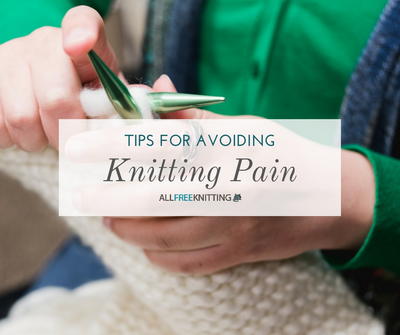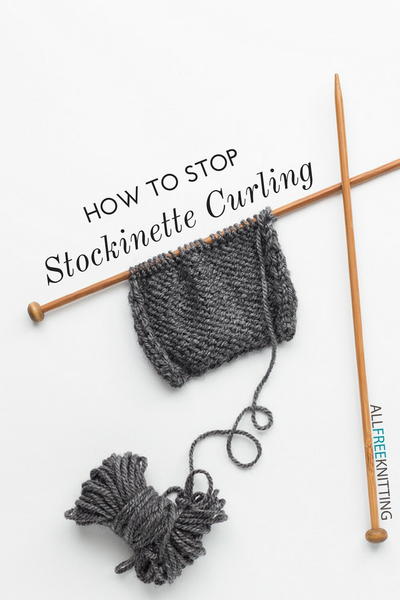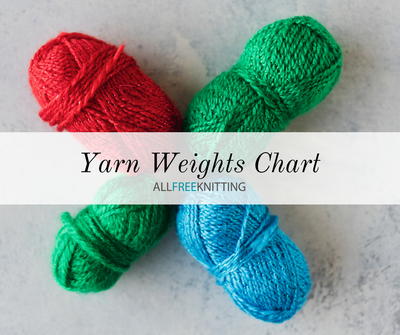Clothes Moths & Yarn: How to Protect and Preserve Your Yarn
Learn how to keep your yarn safe from clothing moths and how to save your yarn after you discover a creepy crawly infestation.
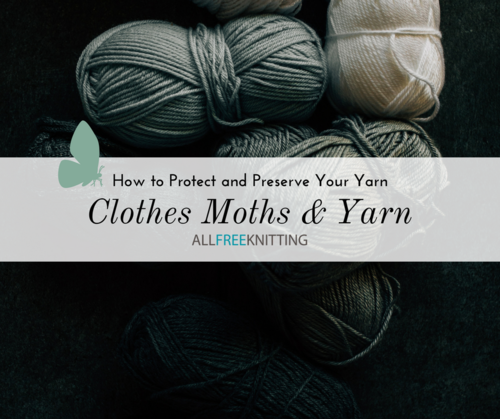
Whether you're a professional yarn hoarder or just a hobby knitter with a small stash, the idea of bugs chomping away at your precious and pretty yarn probably makes your skin crawl. Collecting yarn for later projects or finding a steal on some stunning wool is almost half as fun as knitting itself. Unfortunately, yarn hoarding can be an expensive habit, especially when you don't take care of your yarn. Luckily, yarn stores well and doesn't tend to fade too fast. Introduce clothing moths into your stash, however, and you're in for a world of disappointment.
Clothes moths and yarn are not a good match! These little pests can cause a lot of damage to your yarn stash if you're not careful and they can show up in just about any home. There are actually about 5 different types of moths that can be specified as clothing moths and they can be found on every single continent. Okay, maybe not Antartica, but we don't recommend moving simply for the safety of your yarn.
These little bugs are an unpleasant sight and an even more expensive house guest. While adult moths don't actually feed on yarn or clothing fibers, their eggs and larvae are the real culprits. Moths lay their eggs in clothing or fibers derived from animals (wool, alpaca, etc.) so that their hatchlings have something to feed on when they're born.
Why You Should Worry About Clothes Moths and Yarn
Unfortunately, it is insanely easy to go about your business for days, weeks, even months on end and not realize there is an intruder in your yarn stash. You can easily have clothing moth eggs in your stash and have no idea. While it is likely you will see adult moths in your home (clue number one that you might have a problem), it's entirely possible that you will not. If you're not taking the proper precautions to store your yarn, you could easily have intruders munching away in your closet or under your bed.
Clothing moths, unlike other icky pests, do not prefer a certain type of home or even a particular climate. Even if your house is crazy clean and shiny from a weekly scrub down, moths still could be present in your stored items. Moths very rarely lay their eggs where they can be disturbed. They're skilled at finding the perfect place to lay their eggs, often finding clothing in storage that is not worn often or yarn stashes you stuck under the bed or on a shelf that you haven't moved in months.
While they are often attracted to things like hair or food crumbs, clothing moths can show up in the cleanest of homes. They easily sniff out animal fibers (your yarn!) no matter what where they might be. Moths are more active during the summer because of the humidity but can be a problem all year-long.
What Type of Yarn Do Clothes Moths Eat?
Clothing moth larvae will eat anything with animal fibers in it. Right after being born, the young moths need a lot of protein, which is why they go straight for animal fibers. Generally, plant-based fibers are safe, but if they're dirty, dusty, or covered in hair they will at risk, too.
Types of Yarn Moths Eat
- Wool (Made from Sheep)
- Alpaca (Made from Alpaca)
- Angora (Made from Rabbits)
- Silk (Made from Silk Worms)
- Blends (Combo of Animal Fiber and Plant)
Other Types of Yarn
- As stated above, moths prefer to eat yarns and fabrics made from animal fibers and this is where you will most likely find an infestation. They have been known, however, to destroy other types of yarn or fabric if they are dusty or dirty. While wool, alpaca, angora, and silk yarn are more susceptible to them, it is always a good idea to store ALL of your yarn properly.

How to Identify Clothes Moths, Eggs, Larvae, and Damage
So, how do you tell if you have a moth problem in your home? There are a few ways to spot these little critters. Most notably, seeing moths in your home is an obvious sign. You can also check your yarn/clothing for damage and be on the lookout for eggs.
Spotting a Clothing Moth
One of the first signs that you have a moth problem will often be the appearance of an adult moth. While the adult moths are not the culprit, their presence almost always means there are likely eggs in your home. An adult clothing moth is light tan or brown in color and will grow to about half a centimeter long. They're easy to spot against light walls or fabric. They're tiny, but can be easy to spot if you're looking for them.
As mentioned above, you might not actually see adult moths around when you have an infestation. The eggs and larvae are often in your home for much longer. So, it is a good idea to check up on your stash if it has been languishing in storage for a while.
Identifying Clothing Moth Damage in Yarn
The larvae and eggs are not as easy to spot as the moths themselves as they are very small. Usually, the best thing to look for is the damage itself. You will be able to tell if your yarn has damaged by checking for unusual fraying, messy ends, and more. If you're checking fabric or clothing, small holes will have formed in your piece.
Finding Clothing Moth Eggs in Your Stash
Last but not least, be on the lookout for eggs. These are often found in your carpet and belongings. Moth eggs look like very fine, white or pale crumbs. So, they're much easier to spot on darker yarns.
(Image Cred: Wikimedia Commons - By Aiwok - Own work, CC BY-SA 3.0, Link)
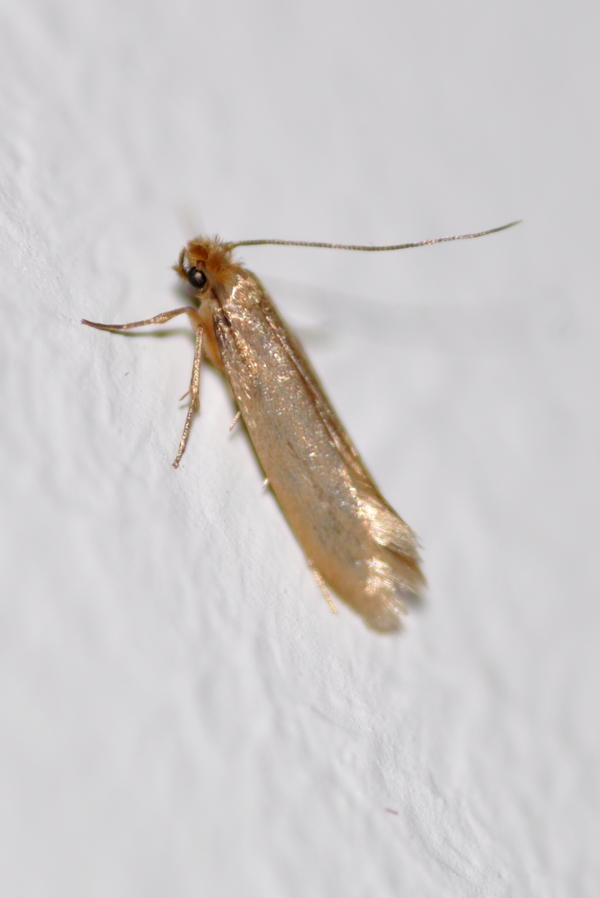
Where Do They Come From and How Do They Find My Yarn?!
Clothing moths are prevalent in homes, storage facilities, stores, and just about everywhere else, so it can often be impossible to tell where they came from in the first place. Really, your best course of action is to take preventative measures at all times. Clothing moths can enter your home from other homes (like your neighbors). This is common in apartment or condo complexes. They often travel on fibers and other yarn, meaning you could inadvertently be bringing them into your home when shopping (especially at thrift stores, garage sales, and resale shops) or even when traveling.
How to Protect Yarn from Moths (Prevention)
The best way to keep moths away from your yarn is to take preventative steps before they even become a problem. If you make your yarn stash hard to find or inhospitable to pests, you'll never have a problem. Storing and caring for your yarn properly is actually pretty easy. Plus, taking proper care of it means it will last much longer - moths or not!
Take the following precautions to keep your yarn safe and sound.
- Always wash or freeze new yarn before placing it with the rest of your stash. This is especially true for gifted yarn or yarn you had shipped to your home. If you don't want to run the risk of having an infestation spread to all your yarn, this is a great step to take. Check out the cleaning/washing your yarn steps in the sections below for more info.
- Store your yarn stash in a safe and sealed container. Moths find clothes by sniffing them out, so if they are sealed shut in a container they should be safe and sound. Good options for this are plastic Rubbermaid containers that seal, space bags (the kind you use a vacuum to seal), or Ziploc bags.
A Note on Cedar! Cedar is the old-fashioned way to prevent moths from getting to your clothes. This method does work as the smell of cedar often throws them off. Keep in mind, however, that this is not as fool-proof as the methods listed above. Vintage and older cedar furniture often lose that scent and is no longer a great deterrent. Cedar drawers and chests may also not be as vacuum tight as other options, especially since old furniture is prone to wear and tear.

- Do NOT display your yarn.
Yarn is gorgeous and it can be very tempting to display it as part of your home decor. We've all seen a lovely rainbow or ombre shelf of soft yarn in craft room photos and all over Pinterest. Choosing pretty over protected can have dire consequences. Not only is your yarn unprotected, but leaving it sitting on a shelf can also allow it to gather more dust and debris, making it even tastier for the little pests. The shelf above looks neat and tidy to you. It looks like a tasty buffet to moth larvae.
- Store with silica gel packets (those little packets that come with new shoes) in order to absorb any moisture.
If you're vacuum sealing your yarn, this might not be a big issue, but it is better to be safe than sorry. Clean and dry yarn will always be harder for moths to spot. Plus, if moisture forms on your yarn, it can get moldy or mildewy.
- Store yarn with lavender, or cedar packets for extra protection.
Since clothing moths seek out animal fibers by scent, masking them with cedar or lavender packets can help deter them from finding your yarn.
Lavender and cedar the best organic options and can easily be purchased on Amazon or you can DIY them on your own. Some natural aromatics are ineffectual in preventing clothing moths (like eucalyptus, mint, bay leaves, or lemon). Much like mothballs, these scents can also be strong and hard to get out of clothing and yarn. Be sure to choose one that you find pleasant and may not irritate your skin or senses.
Note: Cedar is known to be toxic to cats! If you have four-legged friends in your home, lavender might be a better option.

- Do not store yarn with mothballs.
Mothballs are the old school way to get rid of moths, but can actually be pretty dangerous for your home and family. These balls are created with unsafe chemicals that can cause a toxic fume, known to cause anemia and other detrimental health issues. They contain a toxic chemical called naphthalene that can be also be found in jet fuel! It is especially dangerous in small spaces like apartments or confined to one room (like a craft room).
If that doesn't convince you, mothballs have also been known to damage yarn. When stored in plastic bins, it can actually melt the bins and bind to some yarns (like wool). Storing acrylic yarn with mothballs is also not recommended.
- Be diligent when cleaning your storage space.
It can be easy to deep clean your open spaces in your home and skip closets and storage areas. If you know you have had a moth problem before or want to be extra careful, be sure to wipe down these areas regularly. Getting rid of dust build up can really help keep your home moth-free. Simply vacuum and wipe down your space with bleach wipes or a mixture of warm water and white vinegar.

How to Save Yarn from an Infestation of Moths
- Assess the damage and your yarn.
Bad news first! Some yarn might not be salvageable. Since yarn is rolled into skeins or balls, it is easy for moths to cause too much damage to save it. Unroll your skeins to check for damage. If they've eaten their way through several strands, it might not be worth the extra work to try and save it. If the damage is minimal, however, there are steps you can take!
- Quarantine or toss your problem yarn.
If you do find yarn with damage or eggs, you will want to quarantine it ASAP. If you're tossing it out, wrap it in a plastic bag and throw it away in an outdoor waste bin ASAP. If you are going to try and recover these skeins, place them in a Ziploc bag and clothes them up tight.
You will want to separate your "safe" yarn from the infested yarn. If it was all stored in one place, consider washing ALL of your yarn to prevent missing any moth eggs.
- Wash your home and storage space thoroughly.
You will want to do this by scrubbing down your storage space with warm water and vinegar or bleach wipes as well as vacuuming to make sure you get rid of any eggs. Be diligent about any furniture, carpet, upholstery, etc. If possible, clean your mattresses and furniture with a steam cleaner for extra care.
Getting Clothing Moth Eggs Out of Yarn
If you have eggs or larvae in your yarn, it can be possible to save it! While it does take extra work, it can be worth it if the stash is expensive yarn or holds some sort of sentimental value. You will want to wash your yarn to disinfect it. All of the methods below work well. Many knitters actually suggested washing your yarn (in white vinegar) AND disinfecting it (freezing or heating it up).
Washing Your Yarn in White Vinegar
Since you cannot toss yarn in the washing machine, you will have to wash your yarn by hand.
The best way to do this is to wash with a solution of the following:
-1 cup white vinegar
-3 cups lukewarm water
White vinegar is perfectly safe for yarn. It is often used to help set dye into fabrics and fibers, meaning it won't allow your yarn dye to run while you are washing it. Let your yarn soak in this solution for about an hour before rinsing it fully. This should kill all the bugs. Let it dry completely before moving onto disinfecting.
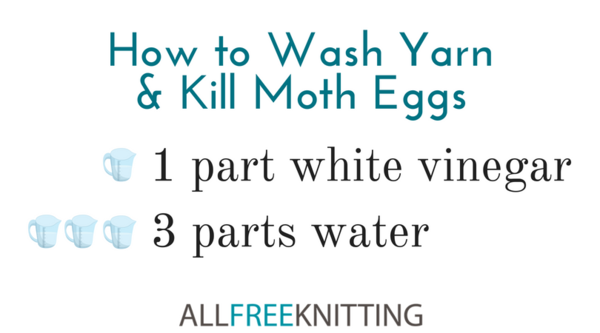
Disinfecting Your Yarn (Killing Clothes Moth Eggs Once & for All!)
Washing your yarn will likely kill all of the yucky little critters hiding out, but it is important to take extra precaution. Disinfecting your yarn can be done one of two ways. You can do this by either cooking or freezing your yarn.
Disinfecting Your Yarn in the Oven
Hot temperatures will kill bugs easily. If you are working with organic yarns, it is completely safe to put them in the oven so long as you keep an eye on them as you do this.
How to Kill Moth Eggs in the Oven
- Remove all paper/rubberbands/etc. on your yarn to avoid damage.
- Bake your yarn in the oven at 150 degrees for 2 hours.
Bonus Tip! Live somewhere that gets super hot? You can also leave your yarn in your hot car for a few days to kill off the eggs!
Disinfecting Your Yarn in the Freezer
Cold temperatures will also kill off moth eggs. So, freezing your yarn is another option. Only do this if you have a freezer that gets to 0 degrees or below. This might mean turning down your freezer a bit while you complete the task.
How to Freeze Your Yarn
- Make sure your yarn is COMPLETELY dry. If you have washed it in the vinegar solution, lay it out and wait a few days in order to make sure all water is gone from the fibers. If ice forms, it can damage the yarn.
- Place yarn in plastic Ziploc baggies and seal tight to prevent any freezer burn.
- Place your yarn baggies in the freezer for a few days.
- Remove and allow to thaw.
- Place yarn baggies back in the freezer for one more week then remove, shake out yarn to remove all eggs, and store properly.
More Tips for Avoiding Moth Yarn Damage
Once you have completed all of the steps above, your home and yarn should be safe and sound. Consider taking the added precautions below.
- Treat new yarn and ALWAYS wash it. Moths can come in from anywhere, especially yarn that has been stored for a long amount of time or shipped
- If you think you bought some infested yarn, let the retailer or store know! You might help prevent this happening to someone else and might even get a refund.
- Make sure to add cleaning your storage space to your chores list each month to make sure you keep it clean and tidy.
- Frequently check up on your yarn and move it around if possible. Moths do not like to lay eggs where they are easily disturbed, so moving your yarn from time to time can help keep them away from it.
How do you store your yarn to keep it safe?
Read NextYarn Weight Categories 101



